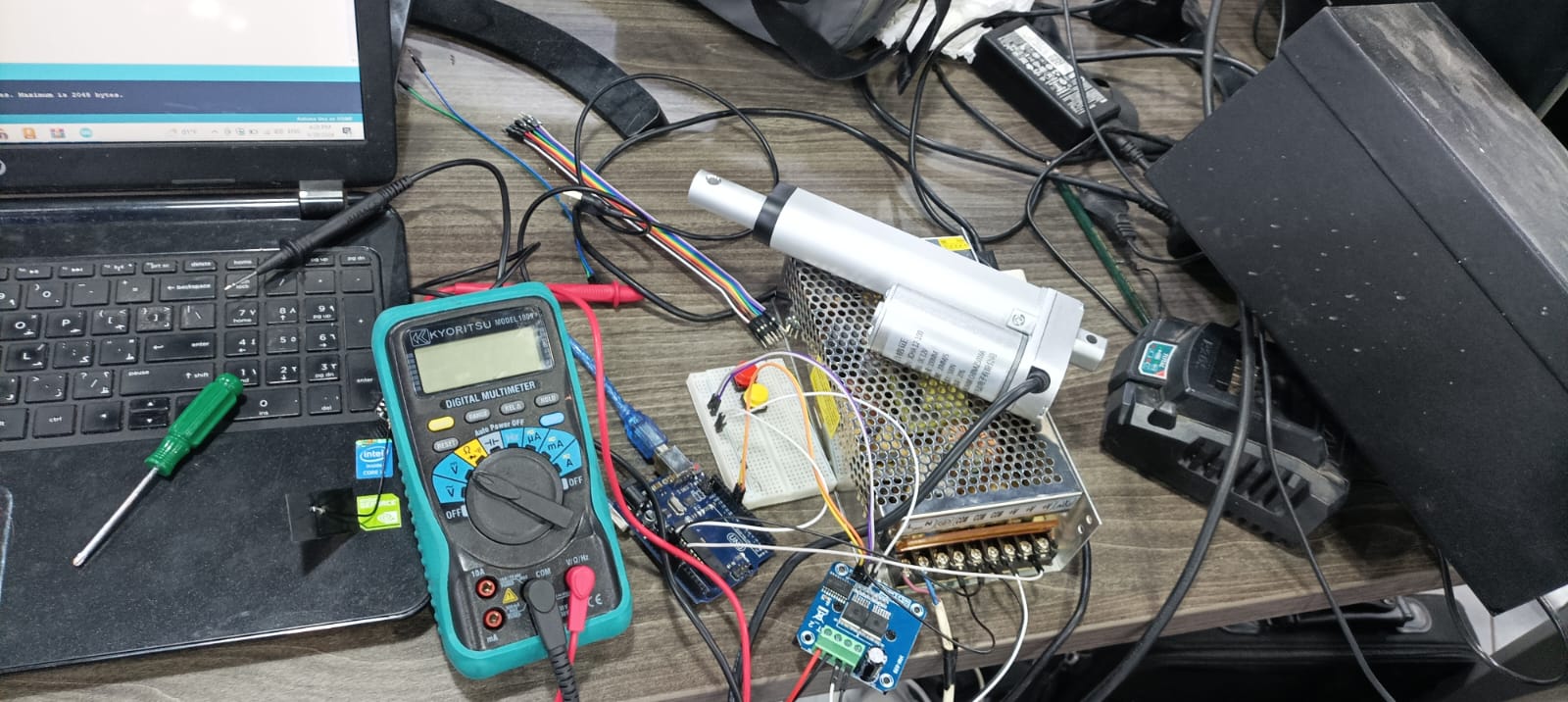Applications and Implications
What Does It Do?
The exoskeleton improves blood flow and reduces pain for individuals with varicose disease by providing mechanical support and mimicking the natural systole and diastole (contraction and relaxation) of leg muscles.
Who's Done What Beforehand?
Previous research and projects have explored exoskeletons for mobility assistance and rehabilitation, such as those used in physical therapy for stroke patients and individuals with spinal cord injuries. Existing solutions for varicose disease typically include compression garments and surgical interventions, but not exoskeletons specifically designed for daily use to improve blood flow and reduce pain.
What Did You Design?
I designed an exoskeleton equipped with:
- An IMU sensor to track leg angles.
- A linear actuator to provide mechanical support.
- A Blynk app to control the actuator, allowing the user to adjust the support level easily.
What Materials and Components Were Used?
- IMU Sensor: For tracking leg movements.
- Linear Actuator: For providing mechanical support.
- Microcontroller: For processing data and controlling the actuator.
- Laser-cut Aluminum or Composite Material: For the exoskeleton frame.
- Fasteners, Straps, and Padding: For comfort and secure fit.
- Blynk App: For user control interface.
Where Did They Come From?
Components were sourced from various suppliers:
- Electronics components (IMU sensor, linear actuator, microcontroller) from a supplier Mikroelectron.
- Frame materials also brought frothe same supplier.
How Much Did They Cost?
| Item | Description | Cost |
|---|---|---|
| IMU sensor | Inertial Measurement Unit sensor | $10 |
| Linear actuator | Device that creates motion in a straight line | $92 |
| Microcontroller | Seeed Xiao ESP32C3 | $7 |
| Materials for the frame | 3D printed parts, acrylic, and PCB design and manufacturing | $43 |
| Velcro | Miscellaneous items for assembly | $2 |
| Total estimated cost | $154 |
- Exoskeleton Frame: Custom-made using laser-cutting processes.
- Sensor and Actuator Integration: Combining IMU sensor and linear actuator with the microcontroller.
- Control System: Developed using the Blynk app for user-friendly interface and control.
What Processes Were Used?
- Laser Cutting: For creating the box that hiding the electronics componenet.
- Soldering and Wiring: For connecting electronic components.
- Programming: For the microcontroller and Blynk app.
- Assembly: For putting together mechanical and electronic components.
What Questions Were Answered?
- Effectiveness: How well does the exoskeleton improve blood flow and reduce pain?
- Usability: How comfortable and user-friendly is the device for daily use?
- Adjustability: Can the device provide the right level of support and adjust in real-time?
What Worked:
- Basic functionality of the exoskeleton.
- The Blynk app control system.
- Initial comfort and usability feedback from my brother.
What Didn't:
- Fine-tuning the fit to better accommodate different leg shapes and sizes.
- Extended testing and evaluation of long-term effectiveness and durability.
How Was It Evaluated?
- Conducted initial trials with my brother to monitor improvements in blood flow and pain reduction.
- Collected feedback on comfort and ease of use.
- Evaluated the device’s performance in real-time adjustments and support.
What Are the Implications?
- Medical Benefits: The device offers a non-invasive, supportive option to help improve blood flow and reduce pain for individuals with varicose disease.
- User Empowerment: It provides users with control over their treatment through the Blynk app, enhancing their quality of life.
- Future Development: There is potential for further enhancement, broader applications, and commercial viability, making it an innovative solution in the field of medical devices.
Mid Term Review
Project Timeline: 2 weeks (14 days)
Tasks:
- Design Phase
- CAD Design of Machine Parts
- Selection of Electronics Components
- Procurement Phase
- Purchasing Components
- 3D Printing Parts
- Assembly Phase
- Mechanical Assembly
- Electronics Integration
- Software Phase
- Marlin Firmware Configuration
- Software Testing
- Testing and Calibration Phase
- Initial Testing
- Calibration and Fine-Tuning
- Final Testing and Documentation
- Final Testing
- Documentation and User Manual
Gantt Chart:
| Task | Duration | Start Date | End Date |
|---|---|---|---|
| Design Phase | 3 days | Day 1 | Day 3 |
| Procurement Phase | 2 days | Day 4 | Day 5 |
| Assembly Phase | 3 days | Day 6 | Day 8 |
| Software Phase | 3 days | Day 9 | Day 11 |
| Testing and Calibration Phase | 2 days | Day 12 | Day 13 |
| Final Testing and Documentation | 1 day | Day 14 | Day 14 |
I'll create the Gantt chart based on this outline.


Alright, let's break it down! Imagine the exoskeleton structure as a lightweight, comfy framework that fits around your leg, designed to help with varicose veins. It's built with sturdy but flexible materials so it can support you without being too bulky or uncomfortable.
Now, inside this structure, we've got some cool electrical components. There are sensors that keep an eye on things like your blood flow and muscle activity, and actuators that can gently squeeze or release pressure to help improve circulation. All these little parts are connected to a small but powerful brain—a microcontroller that makes sure everything works together smoothly.
To keep the exoskeleton running, we use a rechargeable lithium-ion battery. It's compact and lightweight, so you can wear the exoskeleton for hours without feeling weighed down. The wiring, which connects all these components, is neatly tucked away inside the framework to avoid any tangling or discomfort.
For control and communication, we've got a smart system in place. The exoskeleton can talk to your smartphone via Bluetooth or Wi-Fi, allowing you to make real-time adjustments and monitor how things are going. There's probably an app where you can see data, tweak settings, and get feedback, making the whole experience user-friendly and interactive.
In short, this exoskeleton is like a high-tech assistant for your legs, working behind the scenes to keep your blood flowing and your legs feeling good.